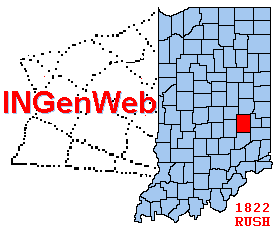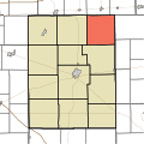

Rush County, Indiana
Genealogy
and History


Rush County, Indiana
Genealogy
and History
Centennial history of Rush County, Indiana Transcribed for the Rush Co. INGenWeb Project by Mark S. Mount
Authors: Anonymous
City of Publication: Indianapolis
Publisher: Historical Pub. Co.
Date: 1921

This is the northeast towship of the county and is bounded on the north by Henry county, on the east by Fayette county, on the south by Union township and on the west by Center township. Raleigh, in almost the exact center of the township, has been the social center of the township since it was laid out many years ago. It was given its name in honor of the capital of North Carolina, in deference to the wishes of a number of Carolinians who had settled in that vicinity. The village of Falmouth, which has been referred to under the caption of Union township, touches Washington township in the southeast corner of the township through which the Pennsylvania railroad runs. Washington township is drained by Flat Rock, Shankitank, Middle Fork and Shawnee creeks, all rather sluggish streams, which were not sufficient at an earlier day to drain the extensive swamp lands which kept back settlement in that part of the county until considerably later than other sections began to fill up, but these swamps have long since been drained by ditches supplementing the creeks and there is now very little land in the township that is not profitably cultivated. Washington township and the town of Raleigh will ever be known as the home of the consolidated township school, such a school having been organized at Raleigh under the direction of William S. Hall as early as 1876, which is said to have been the first movement of the kind in the United States. Mr. Hall, whose ardent interest in school work is referred to elsewhere in this volume, was one of the most influential of the earlier residents of Washington township, served for years as the local justice of the peace, as township trustee, during which latter term of service he performed his notable work of school development, and later represented this district in the state legislature. His son, the venerable Frank J. Hall, now living at Rushville, who was born in this towship, was elected lieutenant governor of Indiana in 1908. It is said that the first white male child born in this township was Kin Prine and first female, Polly E. Jackson. The first marriage was that of John Martin and Prudence Cooke. The first school teacher was John N. Penwell.
Included among the piioneers of Washington township, according to the older chronicles, were John Morgan, Daniel Shawan, Matthew Prine, Richard Knotts, John Cooke, Thomas and Samuel Legg, Peter Younker, Adam and Zachariah Ammon, Marshall and Salathiel Vickery, John and George Maple, William McCann, Elam Irvin, Thomas and Joseph Hall, Joash Cook, Issac Fry, James Prine, Benjamin, William, Joseph and Isaiah Jackson, Samuel Peake, Thomas Colbert, Jesse Scott, John H. Hood, Philip Ertel, Hiram Plummer, John Weaver, Matthew Rippe, David and Lewis L. Canady, John M. Shawhan, Manlove, Jonathan, James I. and Franklin Caldwell, Robert Jeffries, Jacob Parrish, Benjamin Loder, John M. Penwell, Samuel Peake, Thomas Williams, William Beard, Sarah Irvin, Davis Rich, Richard Kolp, Jonathan and Levi Hatfield, James Low, John Reddin and Alfred C. Lightfoot.
Raleigh - It is said that the first house erected on the present site of the town of Raleigh was built by William McCann, who was one of the early settlers in that part of the county and that about 1841 Benjamin Clifford opened a store in that house. This store presently was taken over by Mr. McCann and the hamlet which grew up around the store became locally known simply as McCann's. About 1845 William Beard, whose farm covered the site sold some lots and gave the place the name of Newberne. On October 30, 1847, E. W. Shrader filed a plat of the site under the name of Raleigh and later Mr. Beard and Sarah Irvin made an addition to the original plat. The new plat gave the place the name of Raleigh in honor of the Carolinians who were settlers thereabout, as has been noted above. Raleigh found itself far off the line when the railroads began to come through this section of the state and has remained a pleasant rural hamlet, its present population being in the neighborhood of 150, but it has always maintained high standards and as a social center has ever exerted a wholesome influence throughout that entire countryside; its influence in an educational way particularly having been widespread, as state above. The consolidated school bullding erected long ago under Mr. Hall's thoughtful direction, years ago became inadequate and was supplanted by the present fine school building, a picture of which is found elsewhere in this volume.